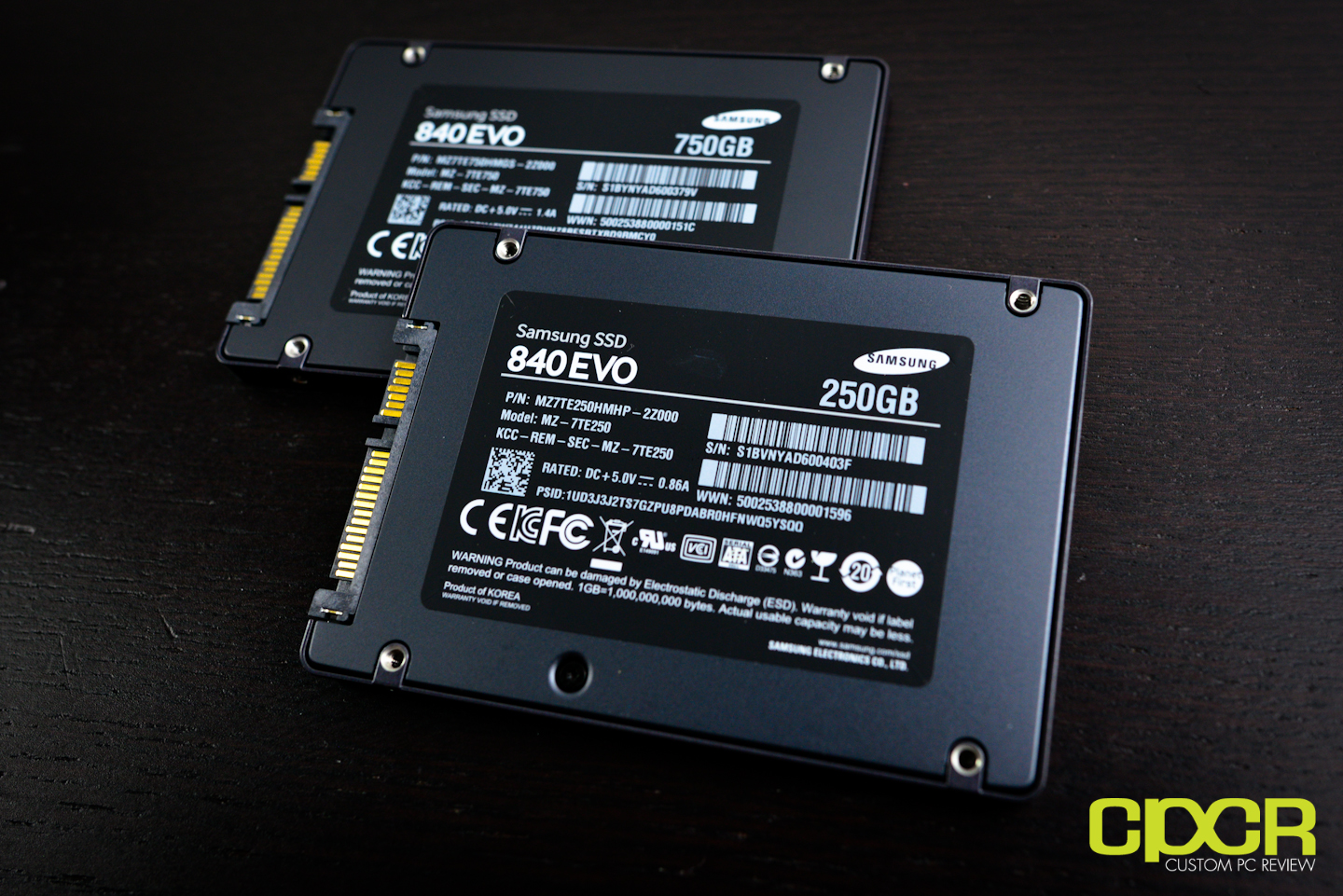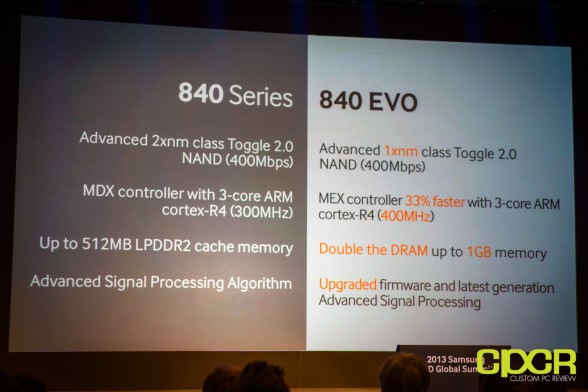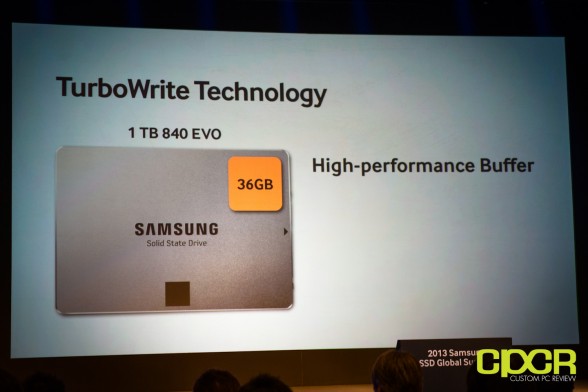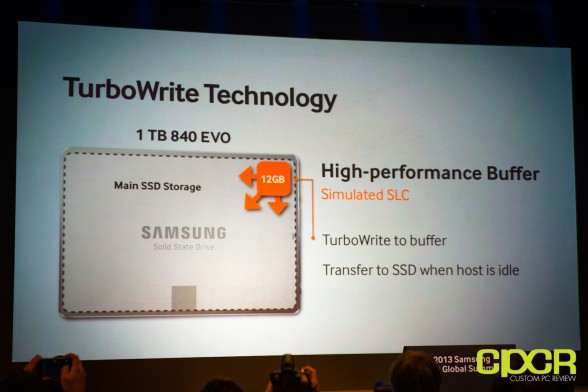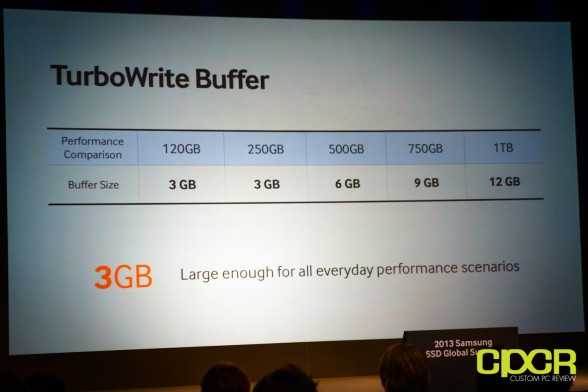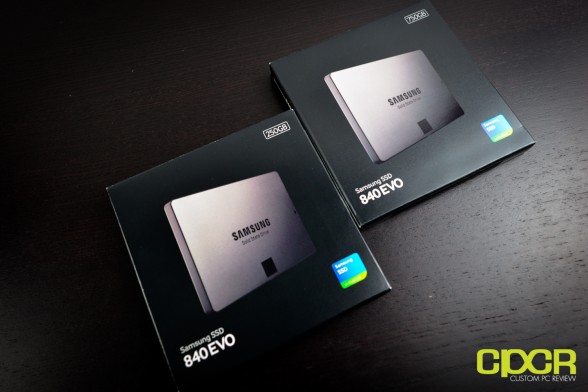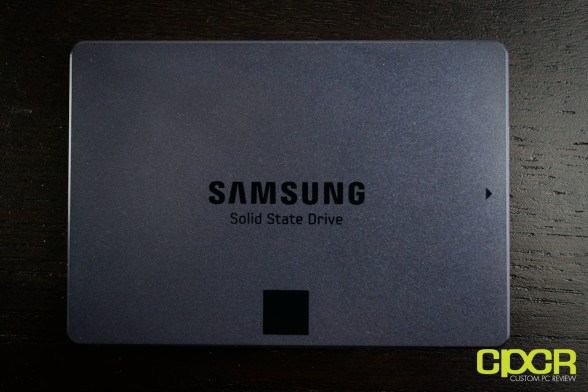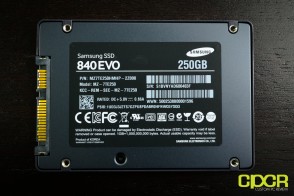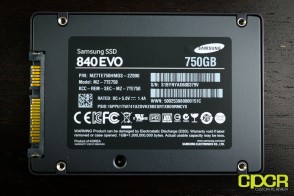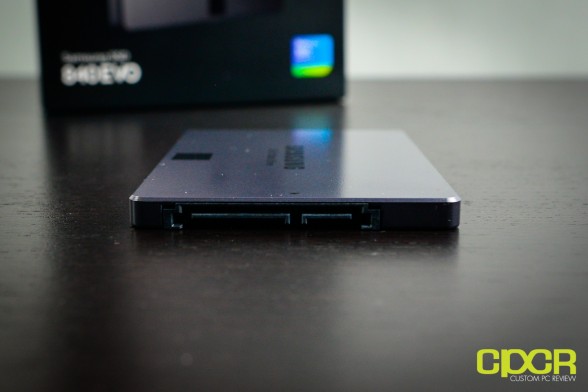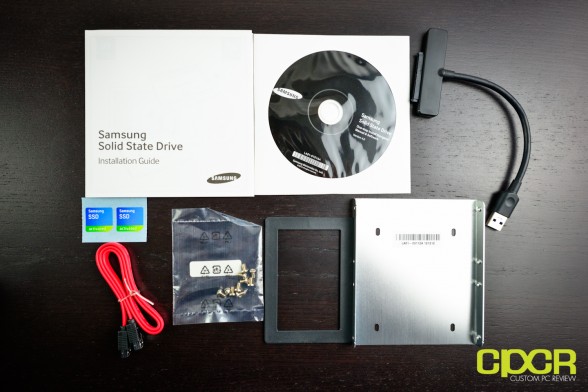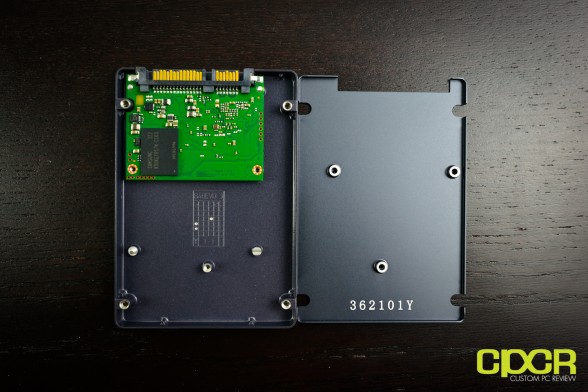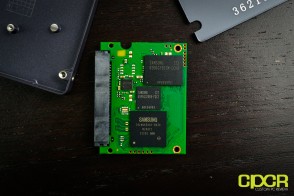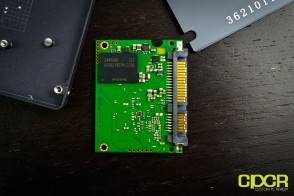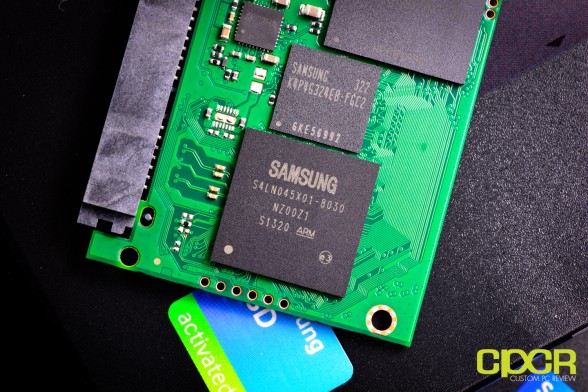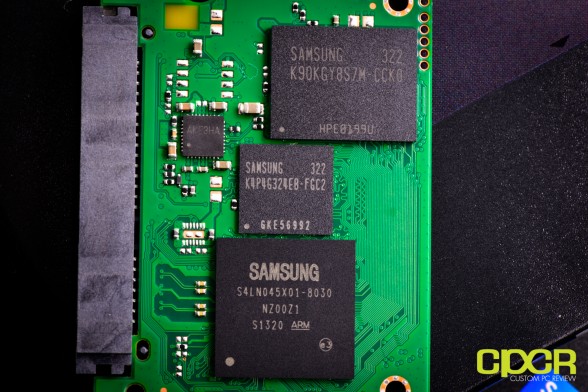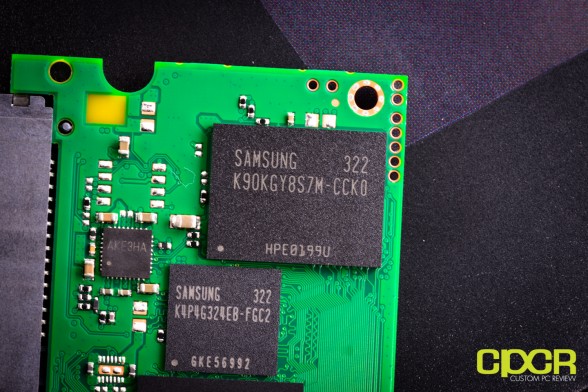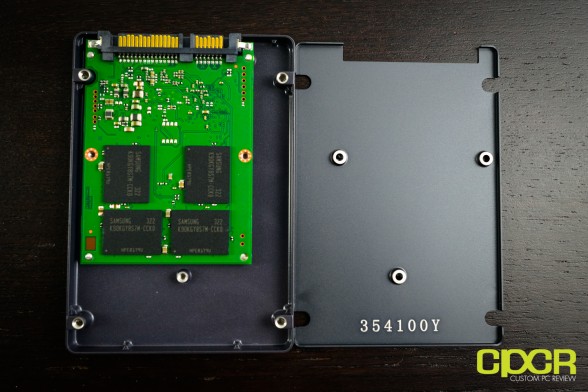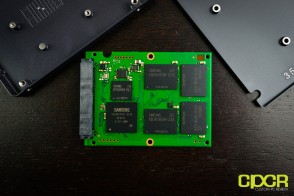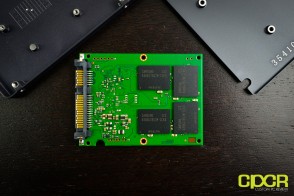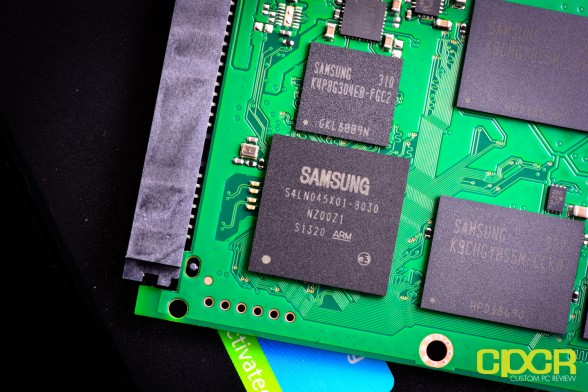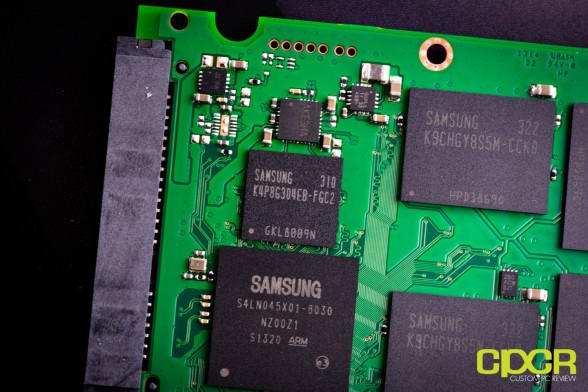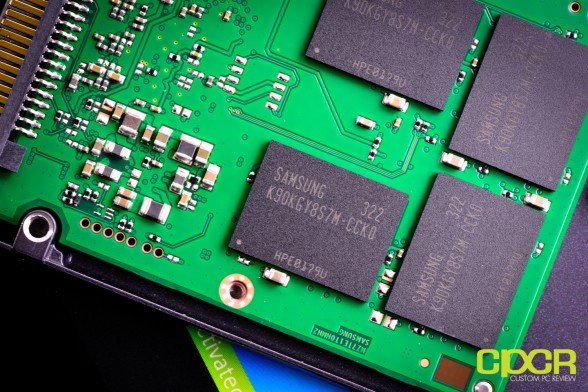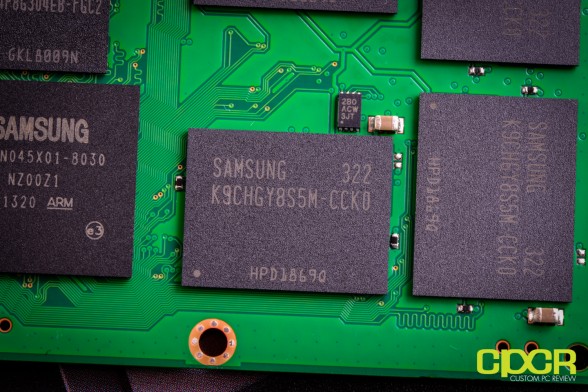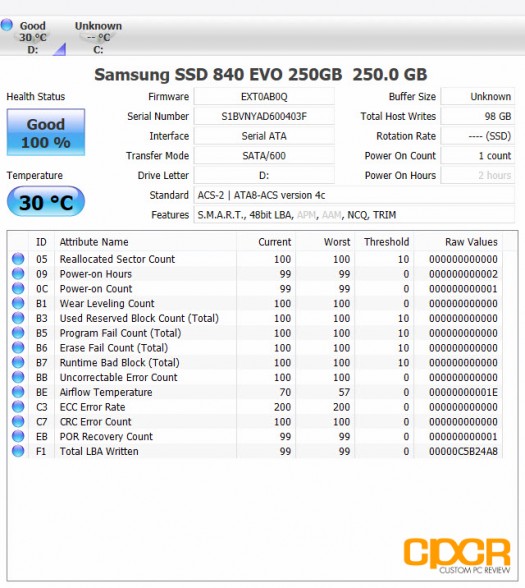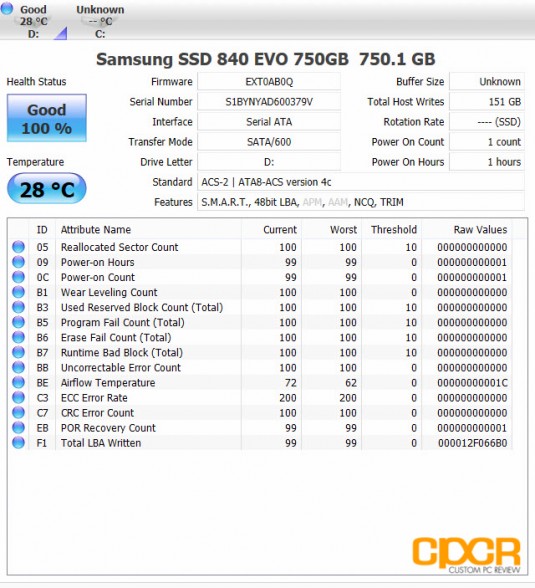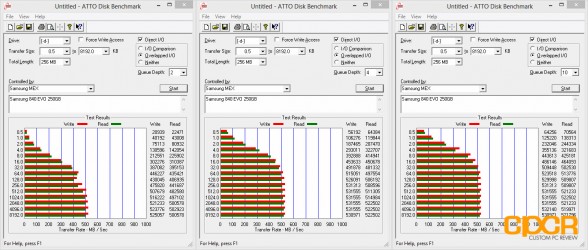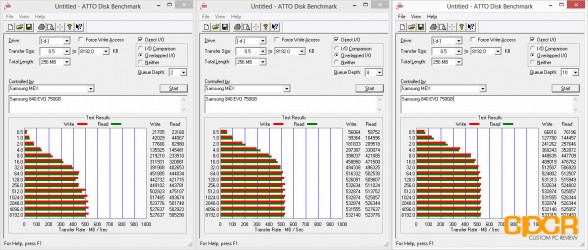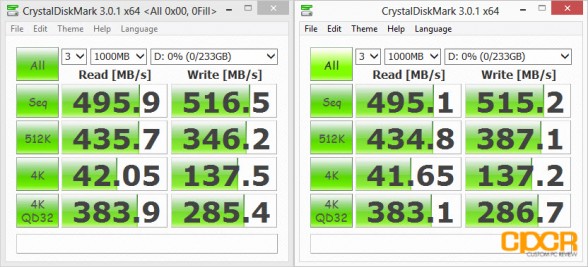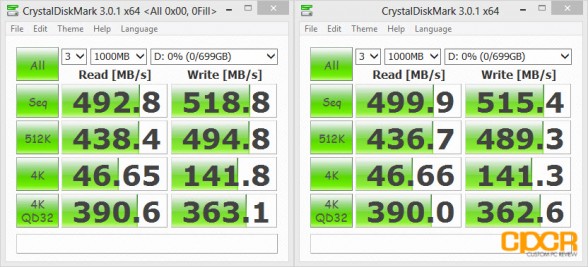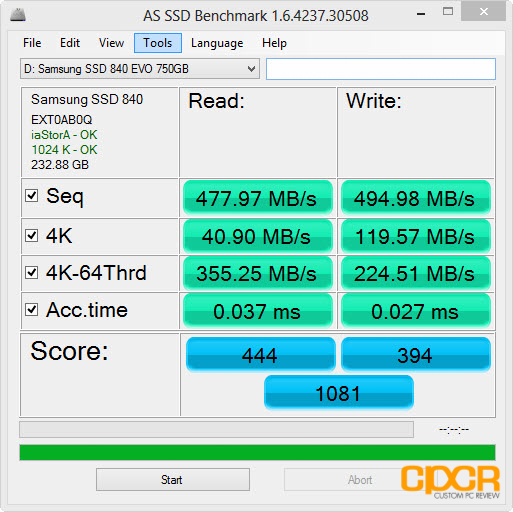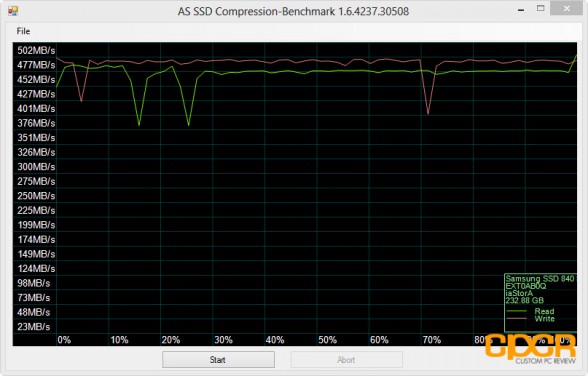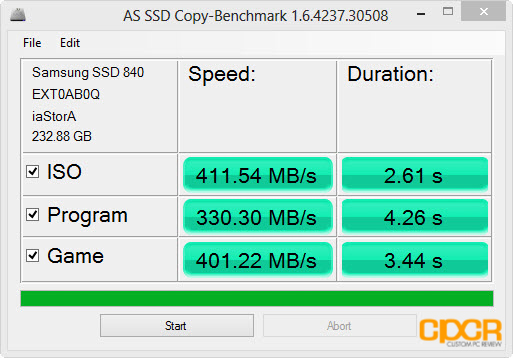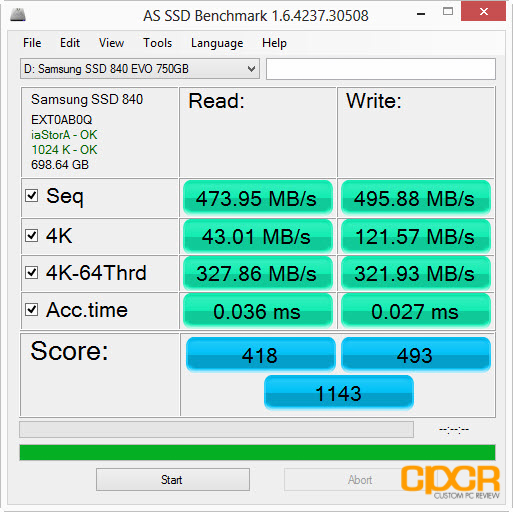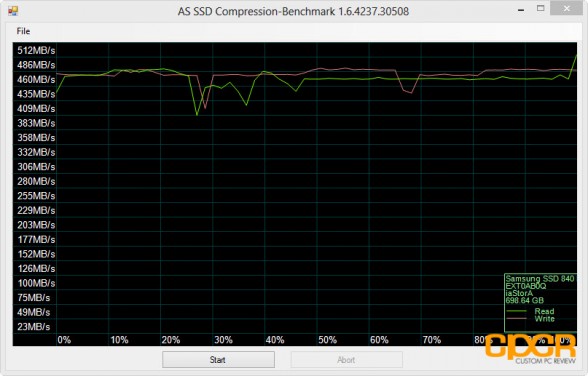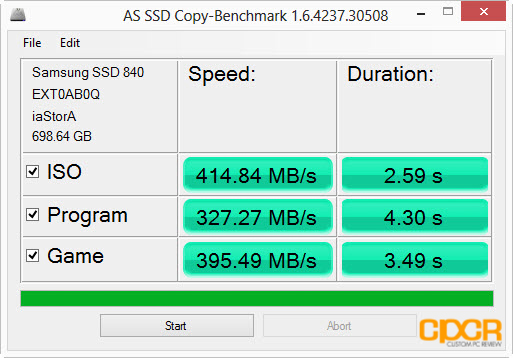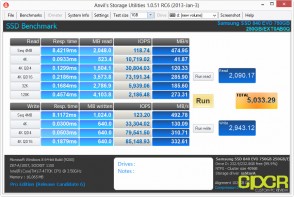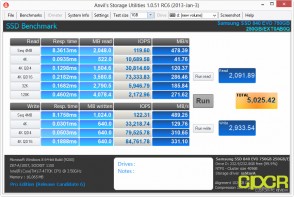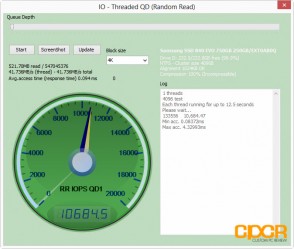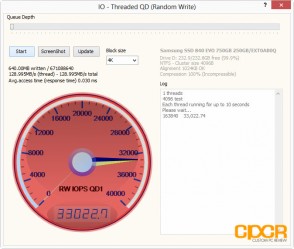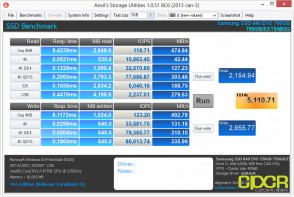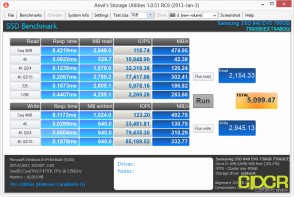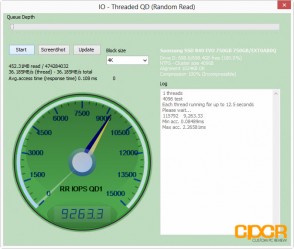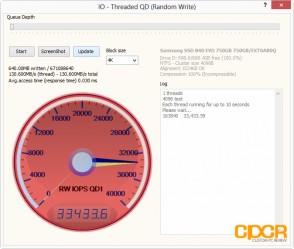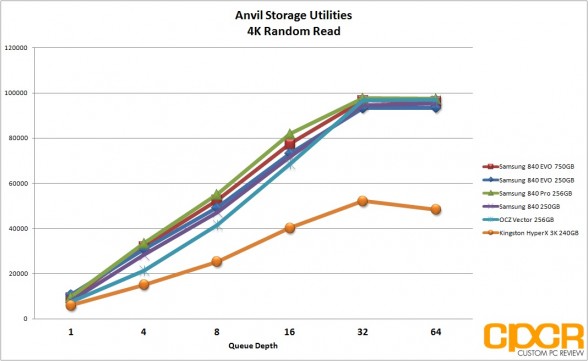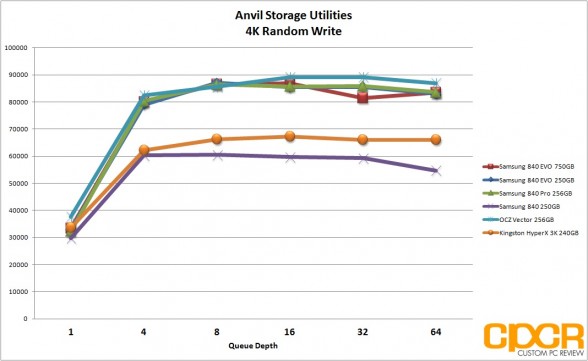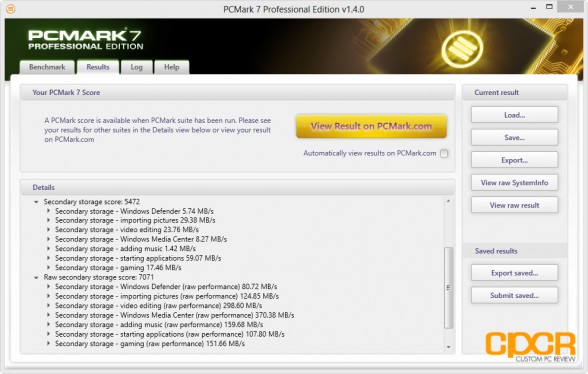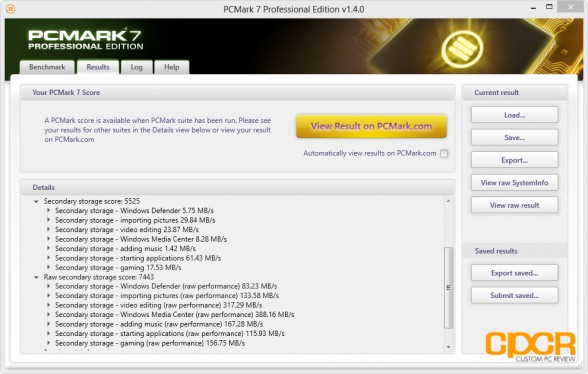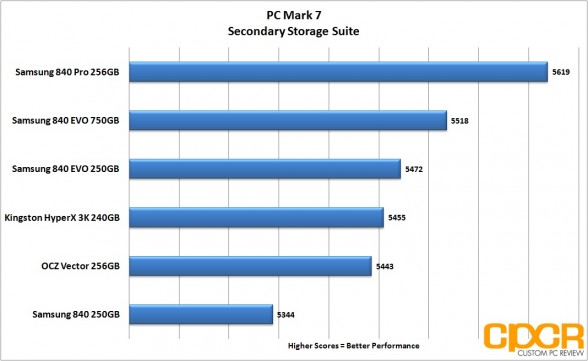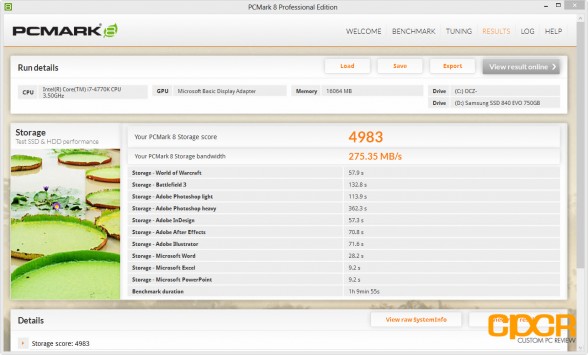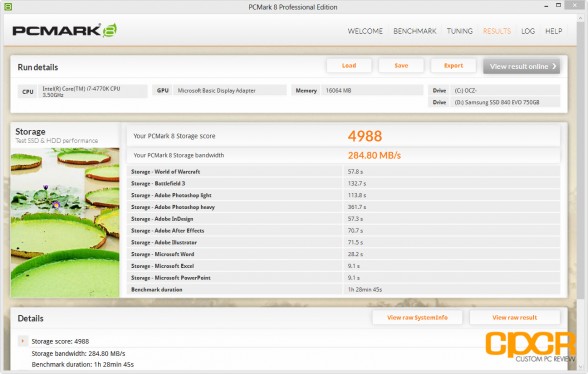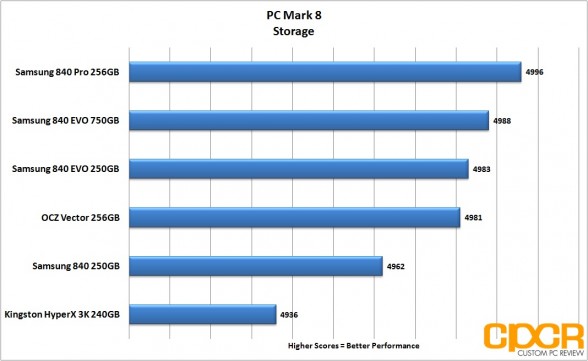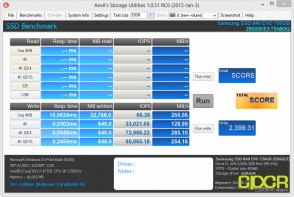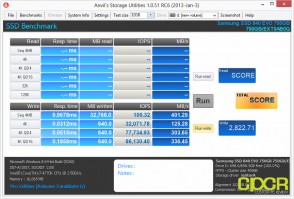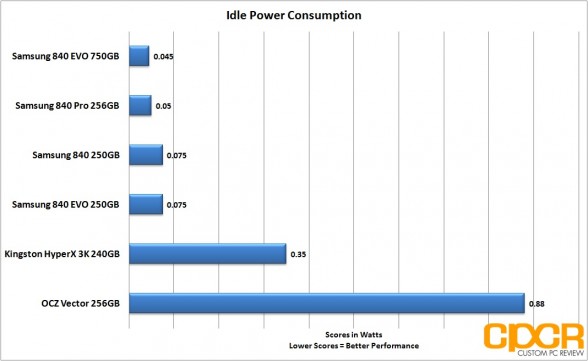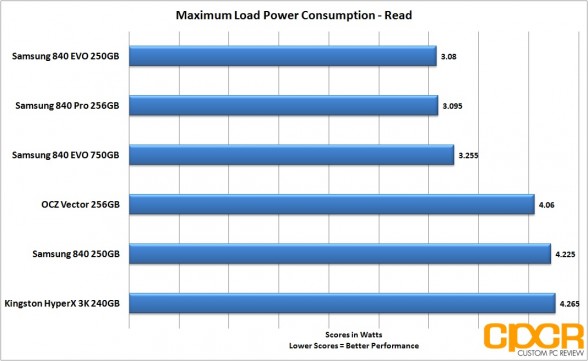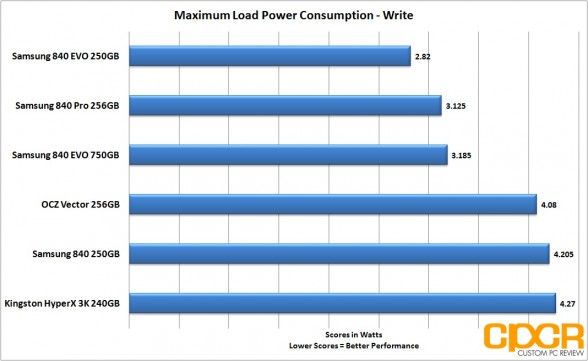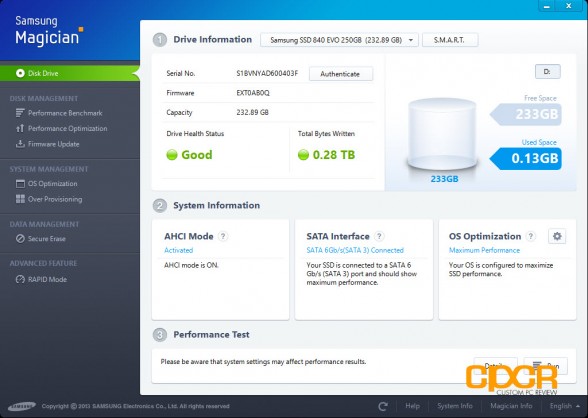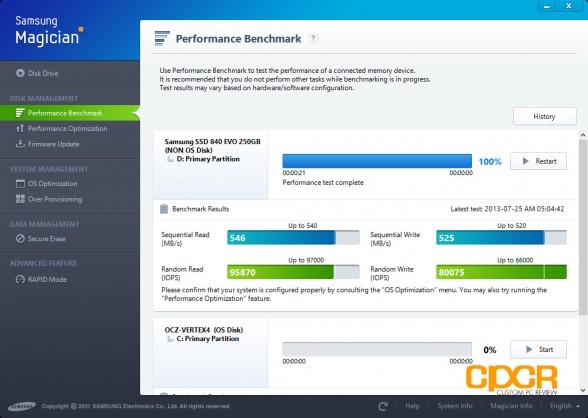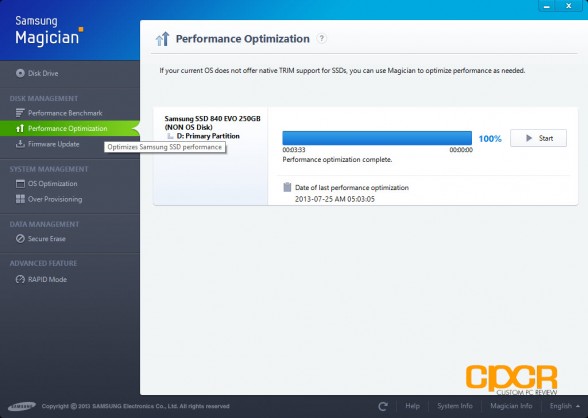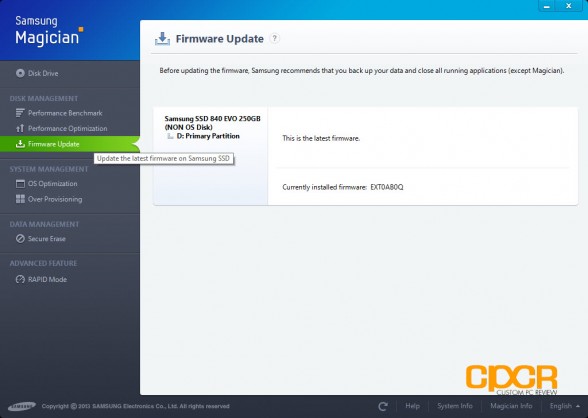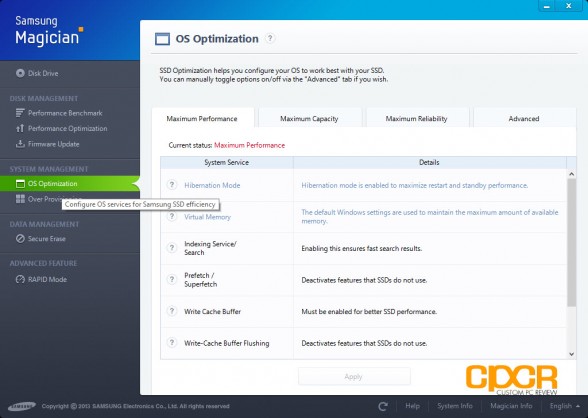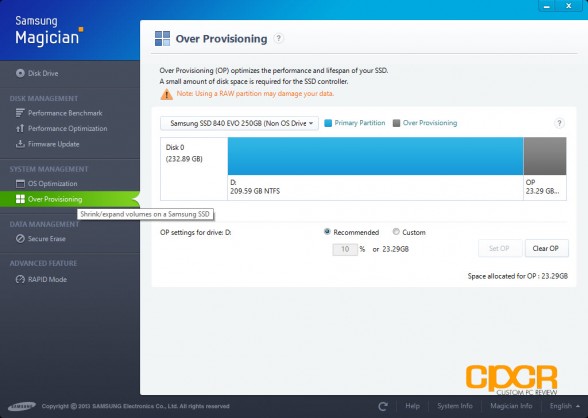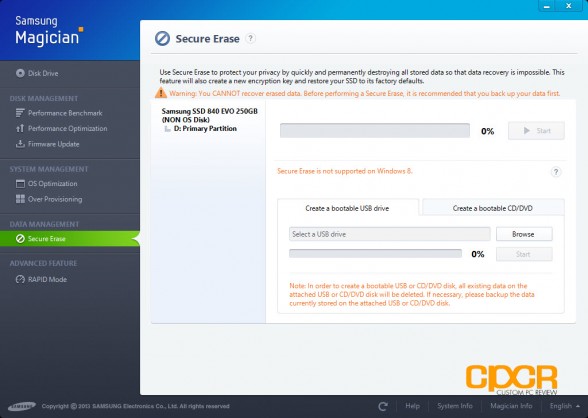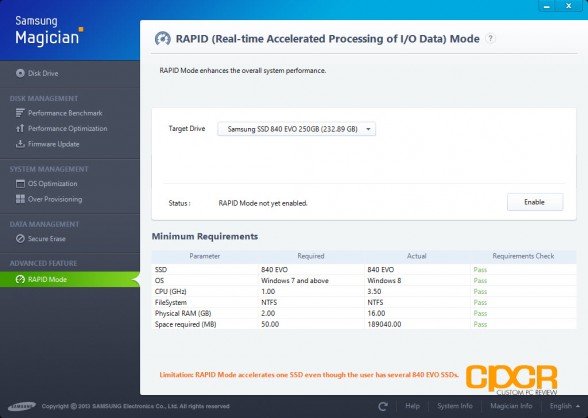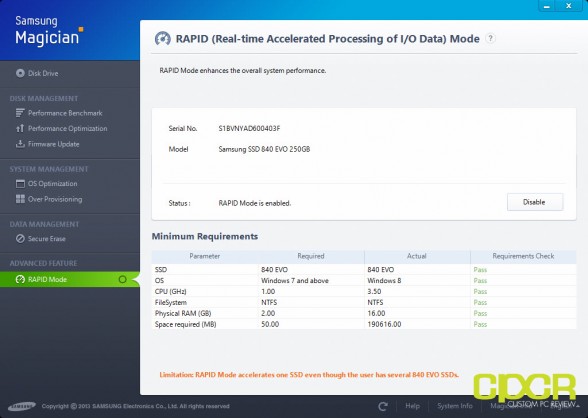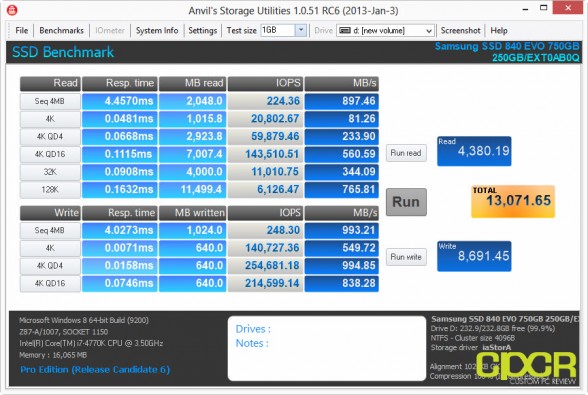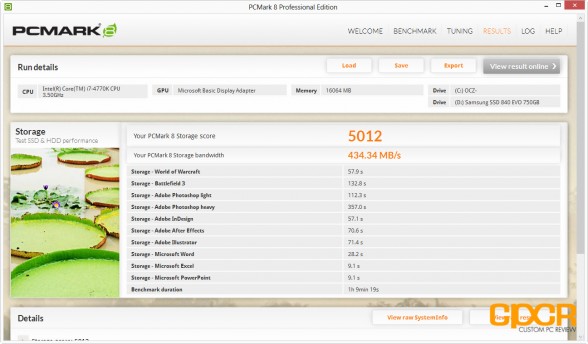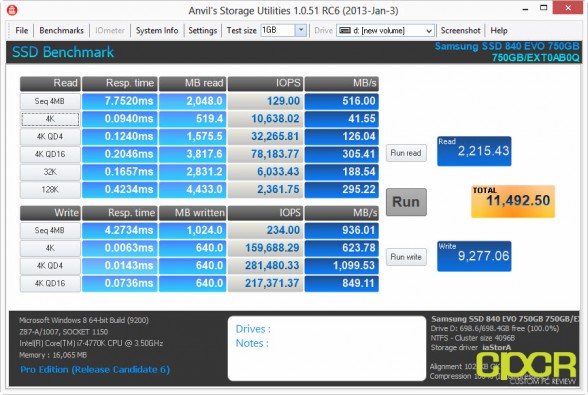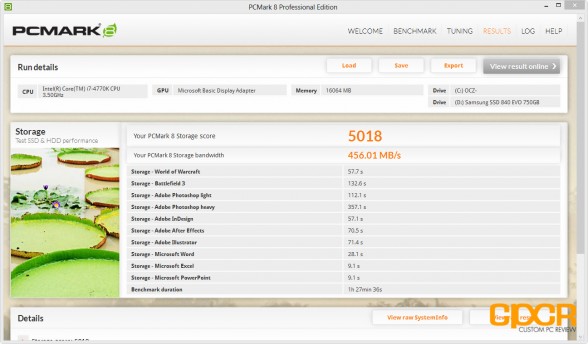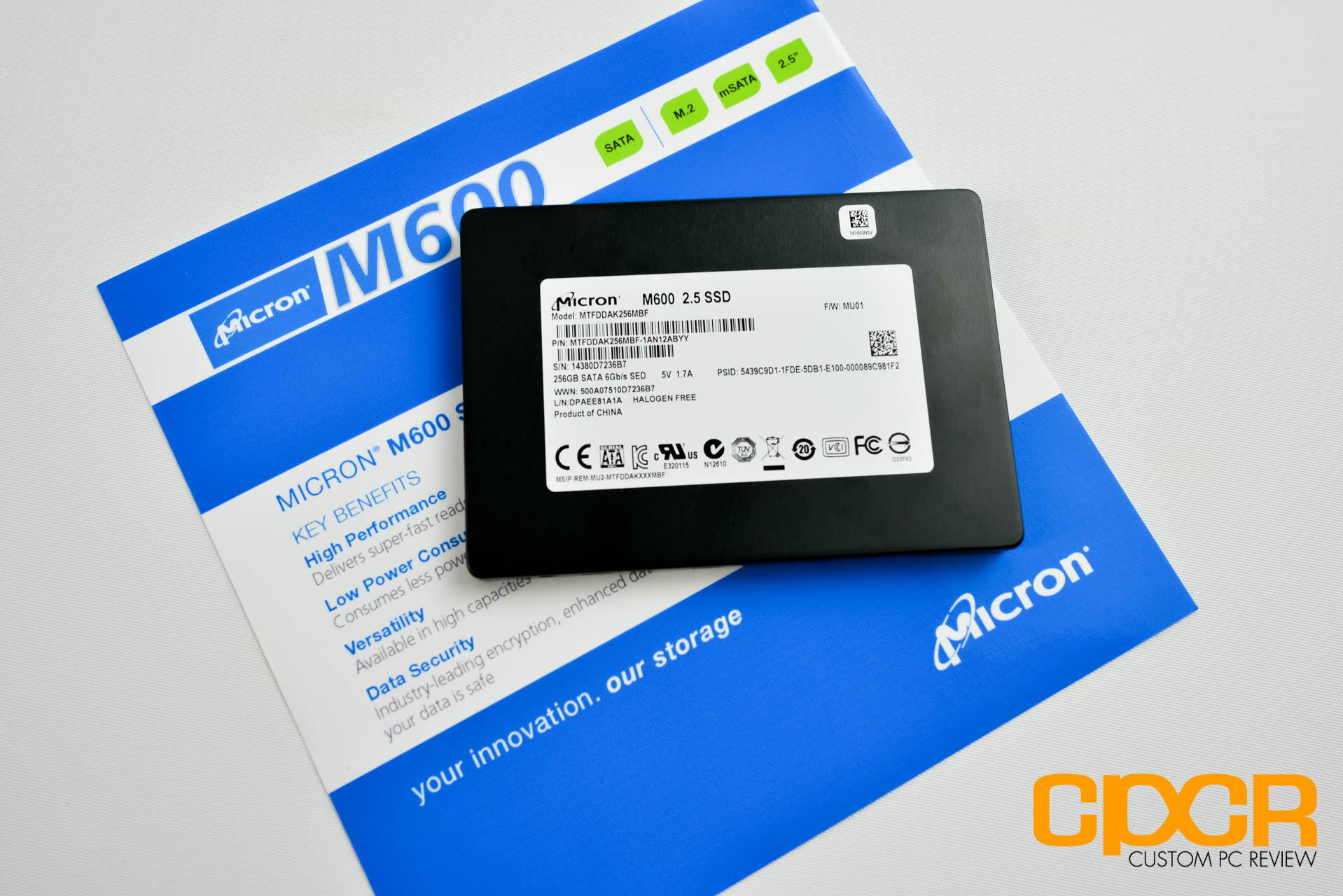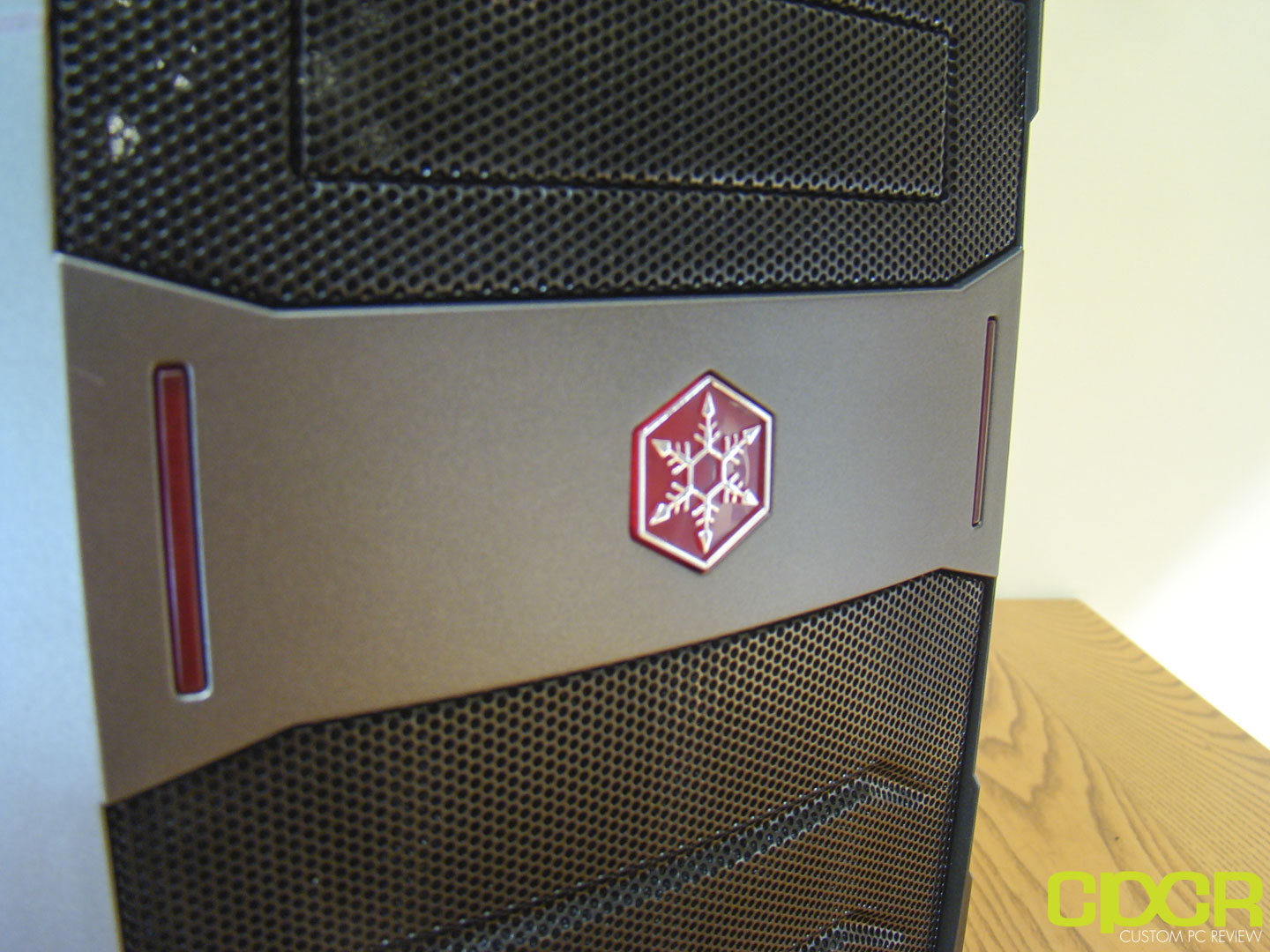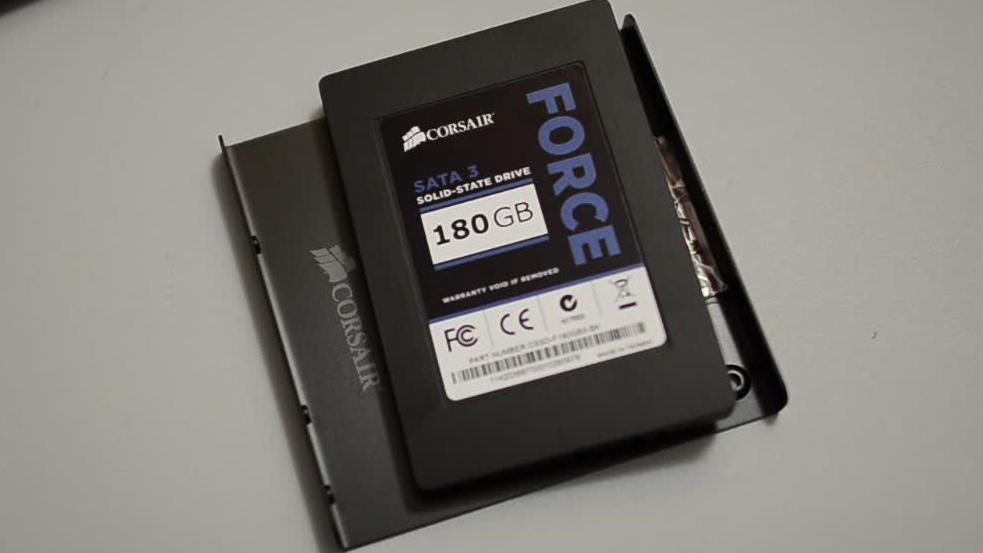[section label=1. Introduction]
840 Evolution
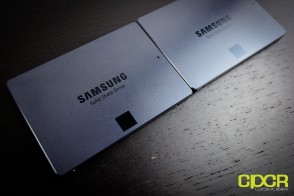 Last year, I had the opportunity of reviewing the original Samsung 840, which I felt was a good effort on the Samsung’s part. Despite the challenges of being the first to market with a TLC NAND based SSD, the Samsung 840 was a decent product and catered very well to its target audience – the general consumer. While the Samsung 840 was a strong product for its intended audience, it wasn’t without its drawbacks – the biggest of which was the write performance.
Last year, I had the opportunity of reviewing the original Samsung 840, which I felt was a good effort on the Samsung’s part. Despite the challenges of being the first to market with a TLC NAND based SSD, the Samsung 840 was a decent product and catered very well to its target audience – the general consumer. While the Samsung 840 was a strong product for its intended audience, it wasn’t without its drawbacks – the biggest of which was the write performance.
Now, when it comes to the SSD market, no other SSD vendor out there is making as much noise as Samsung these days and less than 10 months after Samsung’s initial unveiling of the Samsung 840, they’ve introduced the successor, the Samsung 840 EVO.
Samsung 840 Evo Specifications
| Samsung 840 EVO | Samsung 840 EVO | Samsung 840 EVO | |
|---|---|---|---|
| Capacity | 120GB | 250GB/500GB | 750GB/1TB |
| Controller | Samsung S4LN045X01-8030 | Samsung S4LN045X01-8030 | Samsung S4LN045X01-8030 |
| NAND | 19nm Toggle Mode 2.0 TLC | 19nm Toggle Mode 2.0 TLC | 19nm Toggle Mode 2.0 TLC |
| Sequential Reads | 530 MB/s | 540 MB/s | 540 MB/s |
| Sequential Writes | 410 MB/s | 520 MB/s | 520 MB/s |
| DRAM Cache | 256MB LPDDR2 | 512MB LPDDR2 | 1GB LPDDR2 |
| Interface | SATA 6Gb/s | SATA 6Gb/s | SATA 6Gb/s |
| Warranty | 3 Years | 3 Years | 3 Years |
Today we’ll be reviewing both the 250GB and the 750GB Samsung 840 EVO SSD; however, it’ll also be available in 120GB, 500GB and 1TB flavors as well when it becomes available in early August. As you may have noticed, the capacities here are identical to the capacities found on the original Samsung 840 with the exception that the 840 EVO now has both the 750GB and 1TB capacities.
Now what’s important about the 750GB and 1TB capacities is that Samsung is now a competitor to the recently introduced Crucial M500 SSD, which is available in up to the 960GB capacity. Previous to the introduction of the Curical M500, there really wasn’t much of an option for an SSDs greater than 512GB and if the option were available, the SSD was either terrible or it cost a fortune.
Samsung 830 vs Samsung 840 vs Samsung 840 Pro Specifications
| Samsung 830 | Samsung 840 | Samsung 840 EVO | Samsung 840 Pro | |
|---|---|---|---|---|
| Capacity | 256GB | 250GB | 250GB | 256GB |
| Controller | Samsung S4LJ204X01-Y040 (MCX) | Samsung S4LN021X01-8030 (MDX) | Samsung S4LN045X01-8030 (MEX) | Samsung S4LN021X01-8030 (MDX) |
| NAND | 27nm Toggle Mode 1.0 MLC | 21nm Toggle Mode 2.0 TLC | 19nm Toggle Mode 2.0 TLC | 21nm Toggle Mode 2.0 MLC |
| Sequential Reads | 520 MB/s | 540 MB/s | 540 MB/s | 540 MB/s |
| Sequential Writes | 400 MB/s | 250 MB/s | 520 MB/s | 520 MB/s |
| Warranty | 3 Years | 3 Years | 3 Years | 5 Years |
Here’s a look at the Samsung SSD lineup along with specifications for each of the respective 2xxGB capacity drives. There are a couple different things to note here. First off, we’ve got a new controller on the Samsung 840 EVO. The Samsung 830 used a MCX controller, the 840 and 840 Pro used a MDX controller and now we’ve got a MEX controller with the 840 EVO. Second, we’ve got new NAND. The 840 EVO contains Samsung’s latest 19nm Toggle Mode 2.0 TLC (3 bits per cell) NAND which should help reduce power consumption and increase capacity.
Beyond the new hardware though, what should really catch your eye is the 840 EVO’s performance. Whereas sequential reads were fairly quick even on the original Samsung 840, sequential writes were quite slow, clocking in at only 250MB/s. With the Samsung 840 EVO, Samsung was able to double the write performance pushing sequential writes to a whopping 520MB/s, equaling performance found on the 840 Pro.
[section label=2. TurboWrite Technology]
Higher Performance and TurboWrite Technology
So you’re probably wondering how Samsung managed to to make the 840 EVO so much faster than the original 840 despite using similar performing NAND. The answer to this is twofold – the newer MEX controller and TurboWrite technology. The MEX controller is is pretty straightforward. It’s clocked 33% faster than the MDX controller and Samsung has made a number of tweaks to the firmware, which is why we see an increase in write performance. No surprise there.
On the other hand we also get TurboWrite technology, which is basically a caching solution for writes, which is how Samsung is able to double and even triple write performance of the 840 on the 840 EVO.
How TurboWrite technology works is pretty simple and it’s something we’ve already seen on the SanDisk Extreme II. Since Samsung already has a chunk of extra TLC NAND leftover from over-provisioning, they’ve simply converted this NAND into a simulated SLC high performance buffer (aka a cache). Unfortunately doing so requires a sacrifice of 66% of the NAND so the 1TB edition of the 840 EVO loses a whopping 36GB for only 12GB of simulated SLC; however, the simulated SLC is significantly faster than the TLC in the main SSD storage which is why TurboWrite works. All writes from the host then go straight into the simulated SLC high performance buffer then when the host goes idle, the buffer gets flushed into the main TLC storage area of the SSD.
Now Samsung has predefined the TurboWrite buffer size, which is based off the 840 EVO’s capacity; however, based on their internal testing, they believe that a 3GB buffer should be enough for general everyday use.
If any writes exceed the buffer’s capacity, the SSD will then default to after Turbo-Write performance shown on the table above. Let’s move on…
[section label=3. A Closer Look (Exterior)]
A Closer Look at the Samsung 840 EVO
For our review today, we’ll be taking a look at both the 750GB and 250GB capacities of the Samsung 840 EVO. The Samsung 840 EVO will be available in 120GB, 150GB, 250GB, 500GB, 750GB, and a whopping 1TB. Here’s a look at the packaging for the Samsung 840 EVO. The units I have are bare drives only, but similar to the original 840 notebook upgrade and desktop upgrade editions will be available as well.
Opening up the packaging, we find the Samsung 840 EVO. For the 840 EVO, Samsung used a matte grey type of color despite using a similar design to the 840 and 840 Pro.
Flipping over the 840 EVO, we get a sticker with all the information about the SSD. In order to open it up, the sticker must be broken, voiding the warranty.
Here we get the SATA power and SATA 6Gb/s port in its usual spot. The Samsung 840 EVO is capable of fully utilizing SATA 6Gb/s, so to take advantage of the SSD’s full performance, make sure to connect the SSD to a SATA 6Gb/s port on your motherboard.
While Samsung didn’t provide us with full desktop or notebook upgrade kits with our sample units, they did provide us with the accessories that normally come with the upgrade kits.
Along with some documentation, the notebook upgrade kit will include a 2mm riser (for notebooks with 9mm drive slots only) and a USB 3.0 to SATA adapter. This is an upgrade from the USB 2.0 adapter included with the older Samsung 840 and 840 Pro notebook upgrade kits.
For the desktop upgrade kit, you’ll still receive documentation, but instead of the riser and the USB 3.0 to SATA adapter, you’ll be receiving a 2.5″ to 3.5″ adapter, some mounting hardware, and a SATA cable.
[section label=4. A Closer Look (Interior)]
A Closer Look at the Samsung 840 EVO
Samsung 840 EVO 250GB
Opening up the Samsung 840 EVO 250GB, it’s quite interesting to note just how small the PCB is. Let’s take a closer look.
Unlike the original Samsung 840 and 840 Pro, the 840 EVO makes use of both sides of the PCB rather than a single side. For the 250GB edition, Samsung is only using two NAND packages, the MEX controller, and 512MB of DRAM. Let’s take an even closer look.
Here’s a closer look at the new MEX controller for the Samsung 840 EVO (Model #S4LN045X01-8030). The new MEX controller is an upgrade to the MDX controller found on the 840 and 840 Pro. Like the MDX controller, the MEX controller utilizes a 3-core ARM Cortex-R4 implementation; however, the MEX controller is clocked at 400MHz, which is 100MHz (33%) faster than the 300MHz MDX controller. In addition to the increased clock speeds, the MEX controller also features upgraded signal processing, which is expected to help increase longevity of the TLC NAND.
Right above the controller, Samsung has also included an in house 512MB of LPDDR2 (Model #K4P46324EB-FGC2), which serves as a DRAM cache.
Finally, we also get Samsung’s latest 128Gb 19nm Toggle Mode 2.0 TLC NAND (Model #K90KGY8S7M). For the 250GB edition, Samsung is only using two NAND packages, which pegs each NAND package as carrying a whopping 128GB. Similar to the last generation 21nm Toggle Mode 2.0 TLC NAND, the new 19nm TLC NAND is capable of transfer rates up to 400Mbps.
Samsung 840 EVO 750GB
Here’s a look at the PCB for the Samsung 840 EVO 750GB SSD. Since we’ve got a whole lot more capacity here in comparison to the 250GB edition of the SSD, the PCB is significantly larger here although it’s not quite a full sized PCB.
Like the 250GB 840 EVO, the 750GB 840 EVO also utilizes both sides of the PCB. The front of the PCB includes the new MEX controller, a 1GB DRAM cache along with 4 NAND chips on each side (8 NAND chips total). Let’s take a closer look.
Here’s a look at the MEX controller on the 750GB Samsung 840 EVO. It’s identical to the one on the 250GB edition, so let’s move on.
Here’s a look at the DRAM cache on the 750GB Samsung 840 EVO. The 750GB and the 1TB edition of the Samsung 840 EVO use a Samsung 1GB LPDDR2 DRAM cache (Model #K4P8G304EB-FGC2) in order to support the larger capacity.
Finally, here’s a look at the NAND packages onboard the 750GB Samsung 840 EVO. Samsung is still using their latest 128Gb 19nm Toggle Mode TLC NAND here (Model #K90KGY8S7M-CCK0). The K90KGY8S7M-CCK0 NAND packages each carry 128GB to make up 512GB.
Since this is a 750GB drive, where’s the rest of the NAND? Well, since Samsung doesn’t make 96GB NAND packages, they’re using 4 additional 64Gb 19nm Toggle Mode TLC NAND packages (Model #K9CHGY8S5M-CCK0) to make up an additional 256GB to make 768GB.
[section label=5. Test Setup]
Haswell Test Bench
| System | CyberPowerPC Gamer Xtreme 4200 |
|---|---|
| CPU | Intel Core i7 4770K |
| Motherboard | ASUS Z87-A |
| Memory | Kingston HyperX Genesis 16GB DDR3 2133MHz |
| Graphics | Intel HD4600 Graphics |
| Storage | OCZ Vertex 4 256GB |
| Power Supply | Corsair HX650 |
| Case | HSPC High Speed Tech Station |
| Optical Drive | ASUS OEM DVD Drive |
| Operating System | Windows 8 64 bit |
Special thanks to CyberPowerPC, Kingston, OCZ Technology and HSPC for sponsoring our test bench!
Samsung 840 EVO 250GB
Samsung 840 EVO 750GB
[section label=6. ATTO Disk Benchmark]
Samsung 840 Evo Performance
ATTO Disk Benchmark v2.46
ATTO Disk Benchmark is one of the industry’s oldest and most popular benchmarks for testing disk read/write speeds. This benchmarks allows read and write testing using predefined block sizes and gives us a good idea of read/write speeds with different sized files. Most SSD manufacturers these days prefer using this benchmark when advertising SSDs as it tests using compressible data, which tends to yield better performance.
Samsung 840 EVO 250GB
Samsung 840 EVO 750GB
Performance Analysis
Both the 250GB and 750GB editions of the 840 EVO performed extremely well in ATTO Disk Benchmark, pushing a maximum of 530MB/s+ writes and 530MB/s+ reads. From what I can see here, it’s quite difficult to distinguish between the 840 EVO and the higher end 840 Pro.
[section label=7. Crystal Disk Mark]
Samsung 840 Evo Performance
Crystal Disk Mark 3.0.1 x64
Crystal Disk Mark is another popular benchmark which allows us to measure both sequential read/write speeds as well as random read/write speeds. With this benchmark, tests can be run using both random fill (incompressible data) and 0 fill (compressible data). Realistically in typical computer usage scenarios, data being transferred will consist of a mixture of both incompressible and compressible data.
Samsung 840 EVO 250GB
Samsung 840 EVO 750GB
Performance Analysis
Crystal Disk Mark performance is similar between both the 250GB and 750GB capacities of the 840 EVO. As usual with any non-SandForce based SSD, compression doesn’t affect performance at all. What’s extremely important to note however, is the blazing fast 4K read and 4K write performance. With the original Samsung 840, write performance in general was lacking; however, with the 840 EVO we get 4K write performance that can top even the fastest SATA based SSDs on the market.
[section label=8. AS SSD]
AS SSD Benchmark
AS SSD is a very commonly used benchmark used to measure SSD performance in a number of categories. Here, tests are run using incompressible data, which most simulate real world usage. It also outputs a final score at the conclusion of the test based off the read and write performance of the drive.
Samsung 840 EVO 250GB
Samsung 840 EVO 750GB
Performance Analysis
Because the Samsung 840 EVO doesn’t use compression and is capable of posting incredible sequential and 4k performance, it scores extremely high in our AS SSD testing, pushing performance numbers that rival that of top tier SSDs such as the 840 Pro and the OCZ Vector.
[section label=9. Anvil Storage Utilities]
Samsung 840 Evo Performance
Anvil Storage Utilities
Anvil Storage Utilities is an excellent all around benchmark for testing many different functions of SSD performance. For our purposes, we ran the benchmark through both 0 fill mode (compressible data) on the left and 100% compression (incompressible data) on the right.
Samsung 840 EVO 250GB
Samsung 840 EVO 750GB
Performance Analysis
Firing up Anvil Storage Utilities, we confirm a lot of our earlier findings on the performance of the 840 EVO. Read/write performance here is top notch and the drive is capable of pushing performance similar to the 840 Pro.
[section label=10. PC Mark 7 / PC Mark 8]
PC Mark 7
The PC Mark 7 storage test tests the SSD under many different real world tests such as gaming, video editing, etc. This is most representative of the SSD’s performance under real world situations.
Samsung 840 EVO 250GB
Samsung 840 EVO 750GB
PC Mark 8
The PC Mark 8 storage test is extremely similar to storage test found in PC Mark 7. The PC Mark 8 storage test tests SSDs under many real world applications such as gaming, video editing, photo editing, etc.
Samsung 840 EVO 250GB
Samsung 840 EVO 750GB
Performance Analysis
As expected, the Samsung 840 EVO performed quite well in our PC Mark 7/8 testing as it far outperforms the 840 and is capable of performance almost similar to that of the 840 Pro. Since PC Mark is more representative of real world testing, it deals with a lot of 4K reads/writes along with sequential read/writes under 3GB. Because of this, performance here is extremely good as the 840 EVO does extremely well in both areas.
[section label=11. TurboWrite Technology]
TurboWrite Technology
Before I wrap up on performance testing, I also wanted to test the TurboWrite cache to see the difference in write performance when a file greater than the write cache is written to the drive. According to Samsung, the TurboWrite buffer for the 250GB 840 EVO is 3GB while the TurboWrite buffer for the 750GB 840 EVO is 9GB.
For testing then, I ran Anvil Storage Utilities with a 32GB testfile for both the 250GB 840 EVO and the 750GB 840 EVO in order to fill up the buffer to reach after TurboWrite write speeds.
Samsung 840 EVO 250GB
Samsung 840 EVO 750GB
Performance Analysis
As we can see above, the 750GB 840 EVO’s write performance drops to ~400MB/s once the TurboWrite buffer is filled to capacity, which is roughly 100MB/s slower than the TurboWrite enabled performance. The 250GB 840 EVO’s write performance on the other hand drops to a mere 265MB/s once the TurboWrite buffer is filled to capacity, which is nearly 50% slower than the TurboWrite enabled performance. Luckily, the chances of continuously writing greater than 3GB of data in a general consumer scenario is quite rare, so generally performance should be at the TurboWrite enabled performance rather than the after TurboWrite performance.
[section label=12. Power Consumption]
Samsung 840 EVO Power Consumption
For power consumption testing, we run three tests which consists of idle power consumption, maximum read power consumption, and maximum write power consumption. Real world power consumption will generally fall between the idle and maximum power consumption figures.
All tests below are measured by tapping directly into the 5v line running from the power supply to the drive. All testing here is conducted with “HIPM/DIPM” enabled and “AHCI Link Power Management – Adaptive” set to 0 milliseconds for maximum power efficiency.
Performance Analysis
Samsung drives have always dominated the charts when it comes to idle power consumption and once again with the Samsung 840 EVO Samsung is dominating the charts by a wide margin. With idle power consumption of 0.045w for the 250GB model and 0.075 for the 750GB model, there’s really no other SSD other than Samsung’s own MDX controlled 840 Pro that even comes close. What’s quite impressive is that despite the new MEX controller having a 100MHz faster clock speed than the older MDX controller, the 250GB 840 EVO is capable of besting the 840 Pro’s already impressive 0.05w by reducing idle power draw by 0.005w.
As for load power consumption, the Samsung 840 EVO and the Samsung 840 Pro is once again the most power efficient SSDs tested today. That said, idle power consumption is much more of an important figure as SSDs sit idle for a majority of the time during typical computer use.
[section label=13. Samsung Magician 4.2]
Samsung Magician 4.2
Last year during Samsung’s 2012 Global SSD Summit, Samsung first introduced their latest SSD software utility – Samsung Magician 4.0, which promised a new UI along with greater ease of use. While the Magician 4.0 software didn’t end up officially launching until early this year, it’s now being refined and updated to version 4.2. Here’s a look at the software along with some highlights of the features.
Here’s a look at the main screen when the Magician software is launched. There are a couple cool little stats here along with some SSD optimization information.
The second tab on the left is the “Performance Benchmark” to benchmark the performance of the SSD. The utility itself is quite simple as all you need to do is hit the start button and allow about a minute for the test to run. If the SSD is underperforming in any benchmark, the benchmark utility will suggest that you run the “Performance Optimization” or “OS Optimization” feature.
The third tab on the left is the “Performance Optimization” tab, which issues a TRIM command on the SSD. It’s pretty easy to run by hitting the start button although it shouldn’t be necessary as the SSD conducts its own garbage collection automatically.
The fourth tab is the firmware update tab which should be self explanatory. If a firmware update is available, a button will appear allowing you to update.
The fifth tab is the OS Optimization tab, which will allow you to easily change settings to optimize the OS for use with SSDs. The software includes the option as well as an explanation on the side, so it’s extremely easy to use. You can also go the easy route and use one of the preset profiles. Doesn’t get any easier than “Maximum Performance”, “Maximum Capacity”, and “Maximum Reliability”.
The sixth tab is to adjust the level of over provisioning on the drive. For most users, this should be unnecessary.
The seventh tab is for doing secure erase on the SSD. This is the most efficient way to securely erase all data on the SSD.
Finally, we have the last tab which brings us into an amazing little feature called RAPID mode. More on that when you flip the page…
[section label=14. RAPID Mode]
RAPID (Real-time Accelerated Processing of I/O Data) Mode
Late last year, Samsung acquired a company called NVELO, the company most well known for their Dataplex SSD caching software. At the time, we didn’t know what was going to happen to the company whether Samsung would continue to develop Dataplex or use it for their own purposes, but with the introduction of RAPID mode along with the announcement of the Samsung 840 EVO, it’s clear that the NVELO acquisition has been put to good use.
Included with the new Samsung Magician 4.2 software is RAPID mode, which stands for Real-time Accelerated Processing of I/O Data. The name itself sounds a bit gimmicky sorta like the turbo button on older PCs, but I assure you it’s definitely not. Basically since computers today are extremely well equipped with high performance hardware, RAPID mode is able to leverage the host PC’s additional CPU and memory resources as a caching solution to effectively help improve SSD performance.
As you can see above, RAPID mode for the end user is extremely simple. As long as you meet the minimum requirements, it’s simply an enable or a disable. That’s it. Unfortunately, only the 840 EVO is supported at this time, only a single 840 EVO can be accelerated, and RAIDed SSDs are not supported either. Otherwise, it should work on any relatively modern PC/notebook.
That said, we went ahead and enabled RAPID mode on our test system and ran a couple tests to see just how effective RAPID mode really is. Let’s take a look…
Samsung 840 EVO 250GB
Samsung 840 EVO 750GB
Performance Analysis
From what I can see above, RAPID mode is simply phenomenal to say the least. In Anvil Storage Utilities, RAPID mode was able to push sequential read/write performance to nearly 1GB/s, which is nearly double the performance of the 840 EVO by itself. Similarly, 4K figures are sky high as well with the 750GB 840 EVO pushing an unheard of 159,688 4K write IOPS despite the SSD itself being limited to the SATA 6Gb/s interface.
[section label=15. Conclusion]
Samsung 840 EVO Conclusions
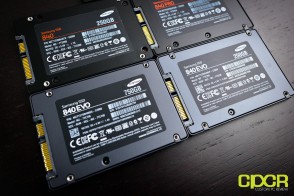 Last year when Samsung first introduced the original 840 SSD, I had two reservations with the drive – performance and reliability. With the Samsung 840 EVO, I think Samsung has done a great job addressing both fronts, so let’s start with performance. When we originally reviewed the Samsung 840, it was apparent that write performance on the drive was slow. Pushing only 250MB/s writes at a time when most other SSDs were breaking the 300MB/s, 400MB/s, and even 500MB/s range, the original 840 was only serious competition for drives based off of asynchronous NAND. However, with the Samsung 840 EVO, Samsung has really leveraged the fact that they own every part of the SSD from the controller and firmware to the NAND to overcome the performance limitations inherent in TLC NAND. With Samsung’s addition of TurboWrite Technology into the 840 EVO, they’ve been accelerate write performance in any application that can fit into the cache space, pushing both read/write performance up to 500MB/s depending on the capacity of the drive. In testing, this was certainly the case and with most client reads and writes being under 3GB, Samsung’s caching solution on the 840 Evo does in fact make a whole lot of sense.
Last year when Samsung first introduced the original 840 SSD, I had two reservations with the drive – performance and reliability. With the Samsung 840 EVO, I think Samsung has done a great job addressing both fronts, so let’s start with performance. When we originally reviewed the Samsung 840, it was apparent that write performance on the drive was slow. Pushing only 250MB/s writes at a time when most other SSDs were breaking the 300MB/s, 400MB/s, and even 500MB/s range, the original 840 was only serious competition for drives based off of asynchronous NAND. However, with the Samsung 840 EVO, Samsung has really leveraged the fact that they own every part of the SSD from the controller and firmware to the NAND to overcome the performance limitations inherent in TLC NAND. With Samsung’s addition of TurboWrite Technology into the 840 EVO, they’ve been accelerate write performance in any application that can fit into the cache space, pushing both read/write performance up to 500MB/s depending on the capacity of the drive. In testing, this was certainly the case and with most client reads and writes being under 3GB, Samsung’s caching solution on the 840 Evo does in fact make a whole lot of sense.
Additionally there’s also RAPID mode, which is like a cache in addition to the cache, which makes everything really damn fast. RAPID mode’s ability to accelerate the 840 EVO’s performance far beyond the limits of the SATA 6Gb/s interface is astounding and I feel like it’s a huge value add especially for those only planning on running a single drive. Hopefully RAPID is something that’ll be rolled out for other SSDs in Samsung’s lineup down the line so those with 830’s, 840’s and 840 Pro’s will have access to the technology.
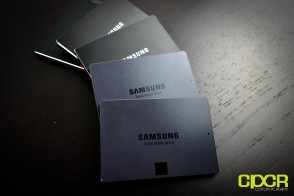 The second concern I had for the original Samsung 840 was reliability and with my own testing, Samsung’s internal testing, and monitoring of reviews on Amazon and Newegg, I’m a whole lot more comfortable recommending TLC NAND based drives compared to a year ago when the technology was fairly new. Samsung claims that based on their internal reliability testing of their TLC NAND, it’s been tested at 2,500 P/E cycles (… and counting), so reliability shouldn’t be a concern, especially with the new MEX controller’s more advanced signal processing.
The second concern I had for the original Samsung 840 was reliability and with my own testing, Samsung’s internal testing, and monitoring of reviews on Amazon and Newegg, I’m a whole lot more comfortable recommending TLC NAND based drives compared to a year ago when the technology was fairly new. Samsung claims that based on their internal reliability testing of their TLC NAND, it’s been tested at 2,500 P/E cycles (… and counting), so reliability shouldn’t be a concern, especially with the new MEX controller’s more advanced signal processing.
Warranty on the Samsung 840 EVO is still the same 3 years offered with the 840 rather than the 5 years offered with the 840 Pro. Personally, I think Samsung being as confident as they are in their TLC NAND technology should be throwing in a 5 year warranty as a show of confidence for the durability of the NAND, but honestly 3 years is probably upgrade time for a vast majority of customers out there.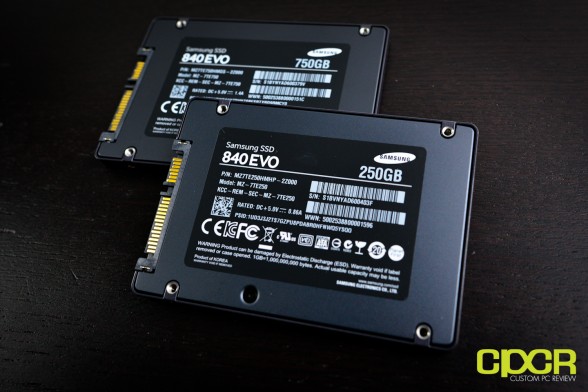
The Samsung 840 EVO should be available at retailers around the beginning to mid August, so actual street pricing isn’t available quite yet; however, Samsung is saying that pricing will be identical to the 840. Since the Samsung 840 EVO will be replacing the Samsung 840 as the entry level, budget oriented drive, competitors will likely be either older SandForce based SSDs such as the SanDisk Extreme, Kingston HyperX 3K, or Crucial’s M500. From a capacity standpoint, the main competitor for the 750GB and 1TB Samsung 840 EVO will be the Crucial M500, which is offered up to a 960GB capacity.
Overall I feel like the Samsung’s 840 EVO is one is a big step forward for Samsung bringing top tier performance to the entry level pricepoint. Those looking for absolute performance and reliability should still opt for the Samsung 840 Pro if possible, although I’d take a good hard look at the 840 EVO as well. The Samsung 840 EVO will provide most customers and enthusiasts plenty of performance, and as far as I’m concerned, it’s the new standard for an entry level SSD. I simply don’t see why you’d go with anything else. Highly Recommended!
Sample provided by: Samsung
Available at: TBD – Early August

